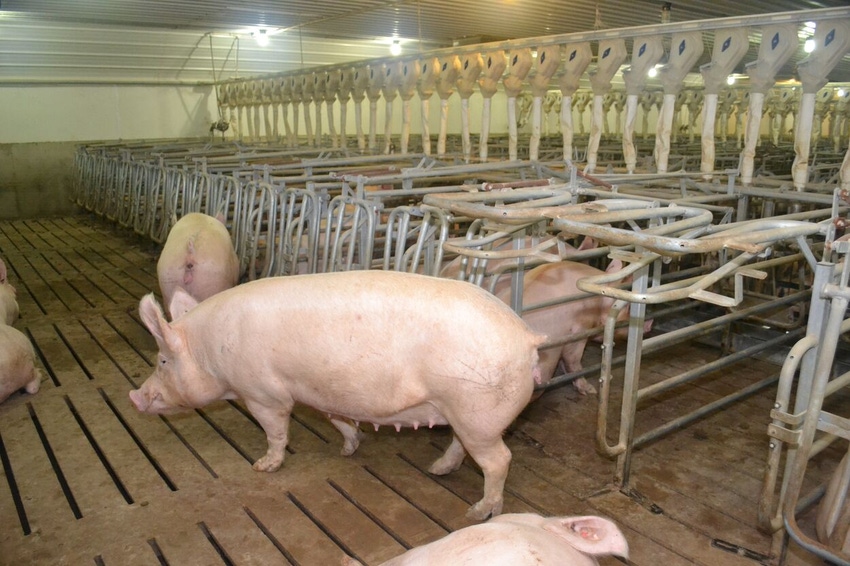What does it take to be Prop 12 compliant?
Not all breeding pigs same size or length; more than 24 feet may be needed to meet requirement for the pig to turn around freely.

When the Superior Court for the County of Sacramento issued an order on July 16 modifying the schedule for California's Proposition 12, the order allowed for the continued sale of non-compliant whole pork meat already in the supply chain. It did not postpone Prop 12 implementation until January 1, 2024. Any hog harvested after July 1, to be sold in California, will still have to be Proposition 12 compliant.
"The news for pork producers is you really need to be moving those," said California State Veterinarian Annette Jones. "If you want to maintain access to your customers that are selling in the California market, your commercial breeding pigs need to be in compliant housing. There's no stay, there's no extension. That really needs to happen quickly if you want to maintain access to the California market."
Jones, along with Elizabeth Cox, animal care program manager for the California Department of Food and Agriculture, detailed the requirements needed to be Prop 12 compliant in a webinar specifically for pork producers Tuesday. The ballot initiative applies to breeding pigs and the pork producers who raises them, and according to CDFA regulations, a producer is defined as a "person engaged in the business of keeping, maintaining, confining and/or housing a female pig of the porcine species that is six months of age or older, or is pregnant for the purpose of commercial breeding to produce pork meat from the breeding pig, or her immediate offspring for human consumption."
"As far as our understanding of how gilts then enter the commercial breeding herd, we understand it's not a hard line at six months of age," said Cox. "And really what's important, as far as this definition of breeding pig, is the term of when she's a commercial breeding pig."
For a breeding pig to be considered Prop 12 compliant, the breeding pig must in a compliant enclosure for the duration of its production cycle, which means:
The life cycle of a commercial breeding pig for the generation of immediate offspring.
The production cycle for gilts which begins when they are six months or older and have moved into enclosure for breeding and ends when a litter of piglets is weaned.
A new production cycle for sows begins when each litter of piglets is weaned.
"This definition helps as far as adult sows can be moved into Prop 12 compliant housing at the beginning of their next production cycle, and then that future production cycle, it's considered Prop 12 compliant," said Cox. "So, the sow doesn't have to be considered Prop 12 compliant since she was a gilt as an adult animal. On her next production cycle, she could be moved into Prop 12 compliant housing and then the immediate offspring from that production cycle is considered Prop 12 compliant."
As for Prop 12 compliant housing, the breeding pig has to be able to stand up, lie down, fully extend her limbs and turn around freely. Turning around freely means turning in a complete circle without any impediment, including a tether and without touching the side of an enclosure for another animal. The enclosure also must have 24 square feet of usable floorspace.
"An enclosure means a structure used to combine a covered animal or animals. A structure means any cage, crate, pen or other construction used to confine a breeding pig. So, as far as the turning around freely and your calculation of 24 square feet of usable floorspace, you want to do that at the level of an enclosure," Cox said.
Usable floorspace can be calculated by dividing the total square footage of floorspace provided to breeding pigs in an enclosure by the number of breeding pigs in an enclosure. The floorspace should also include ground-space for enclosures that are outdoor pens or pastures accessible at all times by all breeding pigs confined in the enclosure.
"Certainly, we understand that maybe not all enclosures are a perfect square or rectangle, but this helps guide people as far as thinking it's the space that's accessible at all times by the animals in that specific enclosure," Cox said. "As far as thinking about your facility, am I compliant, what do I need to do to get ready? If I want to raise pigs that then the meat is sold in California, it has to meet the turning around freely requirement, 24 square feet of usable floorspace, and then this is calculated for each enclosure where breeding pigs are kept."
Cox acknowledged that not all pigs are going to be exactly the same size or length and a 4-foot by 6-foot enclosure may not meet the requirements for the breeding pig to be able to turn around freely. In CFDA's Sow Housing Guide, Exhibit C illustrates an individual pen with 49 square feet of usable floorspace, which allows the sow to turn around freely and would be a compliant housing enclosure.
Group housing is not a requirement for Prop 12 compliance, but could be a practical solution, Cox said. For a facility with an electronic sow feeder, that takes away from the usable floorspace and must be subtracted out, so producers may have to decrease the number of sows per pen. For feeding stanchions, producers can count the feeding space where she can stand and eat and the space where she can turn around freely in the back of the pen. Usable floorspace measurements for a free access stall would be similar with the calculation examining the length and width of the total enclosure and that it is also meeting the turnaround freely requirement.
Exemptions for when the breeding pig doesn't need to be in the compliant housing are during:
Examination, testing, individual treatment or operation for veterinary purposes.
Transportation and slaughter.
Temporary periods of animal husbandry purposes for no more than six hours in a 24-hour period, and no more than 24 hours in a 30-day period.
Rodeo exhibitions, state or county fair exhibitions and similar exhibitions.
The five-day period prior to the breeding pigs expected date of giving birth, and any date that the breeding pig is nursing piglets.
"What this means is that a traditional farrowing crate is allowed under Prop 12, in that she's allowed to be moved into an enclosure that doesn't meet the Prop 12 standards for the purposes of farrowing," Cox said. "And while she is nursing piglets, as long as again, it's within the constraints of it's no more than five days prior to her expected farrowing date, and then when piglets are weaned then she's going to be moved out."
CDFA also further clarified that individual treatment means: "any protocol, practice, procedure, application of care, concern with the diagnosis, treatment, mitigation or prevention of animal disease, injury or harm that is administered by or conducted under the order or a recommendation of a licensed veterinarian as part of a veterinarian/client/patient relationship as defined in the California Federal Code of Regulations."
"It’s at the discretion of the herd veterinarian that has that valid VCP relationship with their pork producer as far as how the individual treatment exception would be applied in regard to confining an individual breeding pig in a non-compliant enclosure under this exception," Cox said.
A pork producer can have a split operation, where they're keeping Prop 12 compliant and non-compliant breeding pigs. The pork producer would just have to demonstrate to the certifying agent for the purposes of certification that they have procedures in place to keep the compliant and non-compliant breeding pigs segregated, and then also the immediate offspring segregated as well. This would then be verified during the onsite inspection by a certifying agent for the purposes of certification.
Certification of pork producers is required by January 1, 2024, and the CFDA is actively building a list of third-party accredited certifying agents for the purpose of certifying production or distribution operation. Pork producers will need to pick their own certifying agent.
The agents will be focused on the operation's confinement standards and that the operation is keeping breeding pigs according to the confinement standards. They will also review the records that a pork producer is keeping as described in the regulations and verify that the pork producer is meeting the record keeping requirements. Pork producer certification includes an onsite inspection and is renewed annually.
"A lot of buyers right now are asking for self-certification from their producers because if you're a distributor here in California, that's in California commerce, is self-certifying that they're providing compliant produce into or product into the marketplace, many of them are asking that their suppliers do the same thing," said Jones. "So, producers may be getting requests for self-certification from their buyers right now, so that could be happening. But officially producers do not have to register with CFDA unless they're a distributor. They would just need to be certified as compliant so they can have access to those ultimate distributors into California."
So, what is the role of a pork producer in a pork distributor audit trail requirement?
"The way the framework was established, the enforcement really happens at the California sale, but the distributor into California is required to have an audit trail all the way back through finishing, farrowing to the commercial breeding operation," Jones said. "So, the producer's obligation would be to have that third party certification in 2024, and then also have records of where your compliant pigs went for finishing and that they've been able to be separated from non-compliant pigs."
About the Author(s)
You May Also Like





